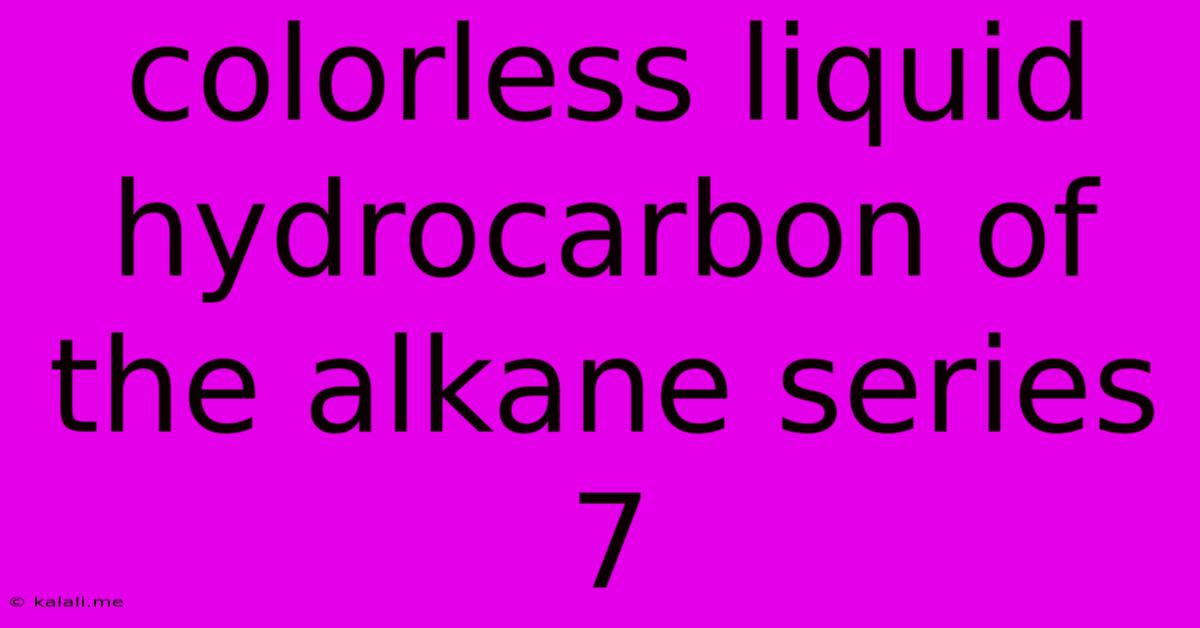Colorless Liquid Hydrocarbon Of The Alkane Series 7
Kalali
Jun 15, 2025 · 3 min read

Table of Contents
Understanding Heptanes: The Colorless Liquid Hydrocarbons of the Alkane Series
This article delves into the fascinating world of heptanes, a group of colorless liquid hydrocarbons belonging to the alkane series. We'll explore their chemical properties, common uses, and safety considerations, providing a comprehensive overview suitable for students, researchers, and anyone interested in organic chemistry. Understanding heptanes involves grasping their structure, isomerism, and various applications in diverse industries.
What are Heptanes?
Heptanes are saturated hydrocarbons, meaning they consist solely of carbon and hydrogen atoms bonded together through single bonds. Their molecular formula is C₇H₁₆, indicating seven carbon atoms and sixteen hydrogen atoms arranged in different structural configurations. This leads to the existence of various isomers, each with unique properties despite sharing the same chemical formula. The term "alkane" signifies the absence of any double or triple bonds within the molecule, contributing to their relatively stable and unreactive nature at room temperature. They are colorless liquids at standard temperature and pressure, exhibiting a characteristic petroleum-like odor.
Isomerism in Heptanes:
The seven carbon atoms in heptane can arrange themselves in numerous ways, resulting in different structural isomers. These isomers possess the same chemical formula but differ in their structural arrangement, leading to variations in their physical and chemical properties, such as boiling point, melting point, and reactivity. The most common isomers include n-heptane (straight-chain), and several branched-chain isomers, such as 2-methylhexane, 3-methylhexane, and 2,2-dimethylpentane, to name a few. The number of possible isomers increases significantly as the number of carbon atoms in the alkane chain grows. Understanding isomerism is crucial for accurately characterizing and utilizing specific heptane isomers.
Properties and Characteristics:
Heptanes are generally non-polar, meaning they don't readily dissolve in water. They are, however, miscible with many organic solvents. Their specific properties, such as boiling point and density, vary depending on the isomeric form. For instance, n-heptane typically has a higher boiling point than branched-chain isomers due to stronger intermolecular forces. These hydrocarbons are relatively unreactive, but they can undergo combustion reactions, readily burning in the presence of oxygen to produce carbon dioxide and water. This property makes them valuable as fuels.
Applications and Uses:
The diverse properties of heptanes make them suitable for a range of applications across various industries:
- Solvent: Heptanes serve as effective solvents in the chemical industry, dissolving fats, oils, and resins.
- Fuel Component: Due to their high energy content, heptanes are often included in gasoline blends to enhance octane rating and improve engine performance.
- Calibration Standard: In analytical chemistry, certain heptane isomers are used as calibration standards in gas chromatography and other analytical techniques.
- Research and Development: Heptanes are utilized in various research settings, especially in studies related to combustion, solvent properties, and reaction kinetics.
Safety Considerations:
While heptanes are relatively non-toxic, they are flammable and should be handled with care. Proper ventilation is crucial when working with heptanes to avoid the accumulation of flammable vapors. Direct contact with skin can cause irritation, and inhalation of significant amounts can lead to respiratory problems. Always consult the Safety Data Sheet (SDS) for specific safety guidelines and precautions before handling heptanes.
Conclusion:
Heptanes represent a significant class of hydrocarbons within the alkane family. Their structural diversity, chemical properties, and various applications highlight their importance in diverse fields. Understanding their isomerism and inherent properties is essential for their safe and efficient utilization. Further research and development continue to expand our knowledge and applications of these colorless liquid hydrocarbons.
Latest Posts
Latest Posts
-
Which Non Metal Is Liquid At Room Temperature
Jun 16, 2025
-
Write 75 As A Product Of Prime Factors
Jun 16, 2025
-
Maximum Number Of Tabs In Excel
Jun 16, 2025
-
How Are Bacteria And Protists Different
Jun 16, 2025
-
What Is The Sum Of The First 50 Natural Numbers
Jun 16, 2025
Related Post
Thank you for visiting our website which covers about Colorless Liquid Hydrocarbon Of The Alkane Series 7 . We hope the information provided has been useful to you. Feel free to contact us if you have any questions or need further assistance. See you next time and don't miss to bookmark.